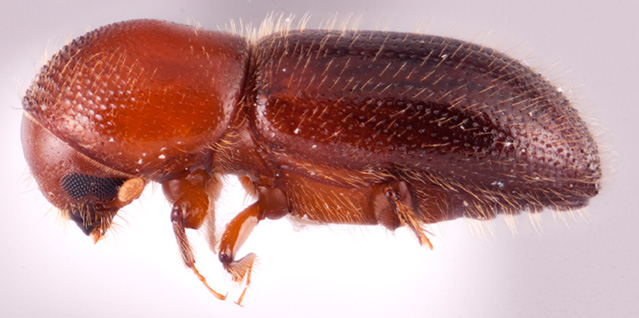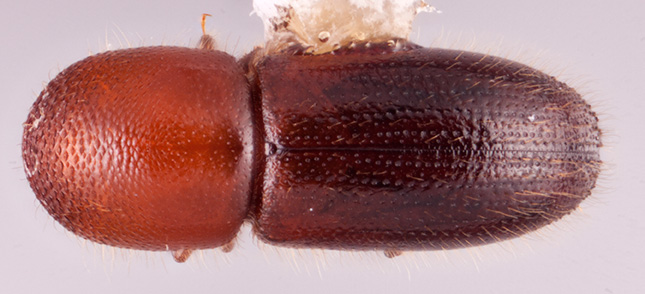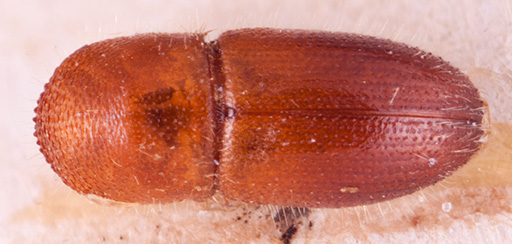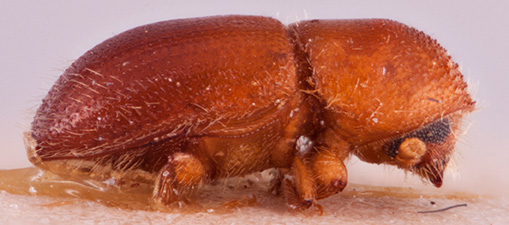Tricosa
|
Tricosa jacula; R.K. Osborn |
|
Tricosa jacula; R.K. Osborn |
|
Tricosa jacula; R.K. Osborn |
|
Tricosa jacula; R.K. Osborn |
|
Tricosa metacuneola; R.K. Osborn |
|
Tricosa metacuneola; R.K. Osborn |
Taxonomy
Tricosa Cognato, Smith and Beaver, 2020 (in Cognato et al. 2020a): 547.
Diagnosis
2.20−3.40 mm long, 2.30−2.91 times as long as wide. Tricosa can be distinguished from all other Xyleborini genera by the following combination of characters: antennalantennal:
pertaining to the antennae
funicle four segmented; antennal clubclub:
the broadened, flattened end of antenna, in Xyleborini comprised of three segments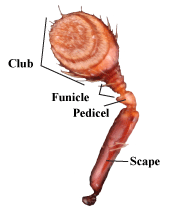 type 3 (Hulcr et al. 2007Hulcr et al. 2007:
type 3 (Hulcr et al. 2007Hulcr et al. 2007:
Hulcr J, Dole SA, Beaver RA, Cognato AI. 2007. Cladistic review of generic taxonomic characters in Xyleborini (Coleoptera: Curculionidae: Scolytinae). Systematic Entomology 32: 568-584. https://doi.org/10.1111/j.1365-3113.2007.00386.x) with one or two sutures visible on the posteriorposterior:
toward the rear end; opposite of anterior
 face; protibia distinctly or obliquely triangular with 6 or fewer denticlesdenticle:
face; protibia distinctly or obliquely triangular with 6 or fewer denticlesdenticle:
a small tooth, the sides of which are equal and the tip is above the middle of the base on outer margin and posteriorposterior:
on outer margin and posteriorposterior:
toward the rear end; opposite of anterior
 face flattened and unarmed; scutellum small, flush with elytraelytron:
face flattened and unarmed; scutellum small, flush with elytraelytron:
the two sclerotized forewings of beetles that protect and cover the flight wings
surface; mycangial tufts absent; elytra attenuateattenuate:
gradually tapering apically
 ; discal punctures seriateseriate:
; discal punctures seriateseriate:
arranged or occurring in rows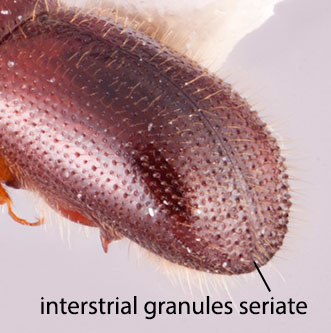 ; and posterolateralposterolateral:
; and posterolateralposterolateral:
relating to end of the side part/portion
 costacosta:
costacosta:
elevated ridge that is rounded at its crest, not necessarily with sharp appearance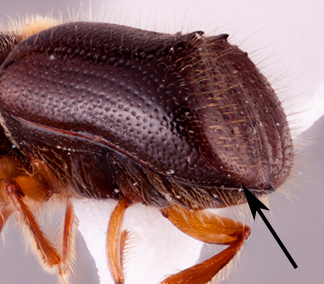 absent.
absent.
Tricosa resembles Cyclorhipidion, Cryptoxyleborus, and Fraudatrix, with which it shares either a setose and/or an attenuateattenuate:
gradually tapering apically
 appearance. Tricosa is most similar to Cyclorhipidion with which it shares a setose appearance and can be distinguished from by the following diagnostic characters (Tricosa given first): protibiaprotibia:
appearance. Tricosa is most similar to Cyclorhipidion with which it shares a setose appearance and can be distinguished from by the following diagnostic characters (Tricosa given first): protibiaprotibia:
tibia of the first pair of legs
obliquely triangular vs semi-circular with evenly rounded outer edge; typically attenuateattenuate:
gradually tapering apically
 elytra vs rounded, truncatetruncate:
elytra vs rounded, truncatetruncate:
appearing cut off or suddenly shortened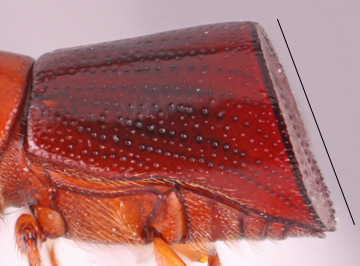 or excavatedexcavated:
or excavatedexcavated:
with a depression that is not in a segment of a circle
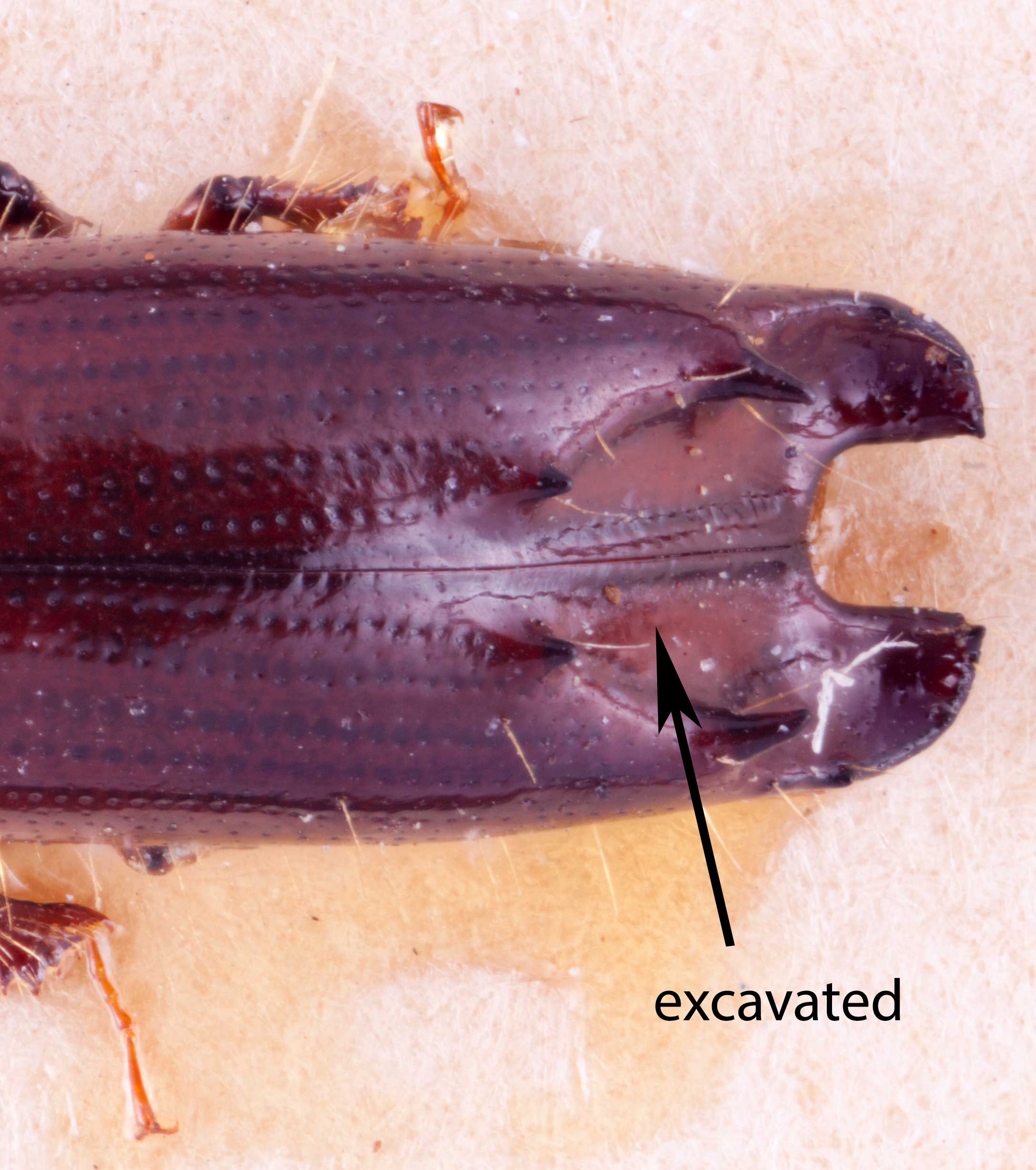 ; outer margin of protibiaprotibia:
; outer margin of protibiaprotibia:
tibia of the first pair of legs
with 5–6 socketed denticlesdenticle:
a small tooth, the sides of which are equal and the tip is above the middle of the base vs 6–9+; anterioranterior:
vs 6–9+; anterioranterior:
the front or forward; opposite of posterior margin of the pronotumpronotum:
margin of the pronotumpronotum:
the dorsal surface of the thorax
typically serrate vs unarmed (rarely serrate). Tricosa can be distinguished from Cryptoxyleborus by the visible scutellumscutellum:
a shield-like sclerotized plate located at the midpoint of the elytral base
, and from Fraudatrix by the four segmented antennalantennal:
pertaining to the antennae
funicle and antennalantennal:
pertaining to the antennae
club type 3 (Hulcr et al. 2007Hulcr et al. 2007:
Hulcr J, Dole SA, Beaver RA, Cognato AI. 2007. Cladistic review of generic taxonomic characters in Xyleborini (Coleoptera: Curculionidae: Scolytinae). Systematic Entomology 32: 568-584. https://doi.org/10.1111/j.1365-3113.2007.00386.x) with one or two sutures visible on the posteriorposterior:
toward the rear end; opposite of anterior
 face, and the pronotalpronotal:
face, and the pronotalpronotal:
pertaining to the pronotum
discdisc:
the flat central upper surface of any body part (e.g. pronotum and elytra) as long as or shorter than the anterioranterior:
as long as or shorter than the anterioranterior:
the front or forward; opposite of posterior slope.
slope.
May be confused with
Cryptoxyleborus, Cyclorhipidion, and Fraudatrix
Distribution
throughout the Oriental region and New Guinea
Gallery system
Not described

